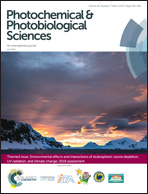Interactive effects of solar UV radiation and climate change on material damage
Abstract
Solar UV radiation adversely affects the properties of organic materials used in construction, such as plastics and wood. The outdoor service lifetimes of these materials are influenced by their rates of degradation under solar UV radiation as well as by other climate factors such as temperature, moisture, and atmospheric pollutants. While recovery of the stratospheric ozone layer is expected, local increases in UV radiation are still likely to occur, especially in the tropics, but also elsewhere because of climate change effects. Such increases, when taken together with an increased ambient temperature due to climate change, can significantly shorten the service lifetimes of organic building materials. Several proven technologies, including the use of UV stabilisers, surface treatments or coatings have been developed over the years to mitigate these adverse effects. While these technologies should be able to compensate for any realistic future UV radiation and climate change scenarios, they will also add significantly to the lifetime cost of material in relevant products. Shorter outdoor lifetime of the plastic components in photovoltaic (PV) modules is a serious concern in the solar energy industry. To ensure module durability over the full service-lifetime (of about ∼20 years) of the light-harvesting PV components, better stabilisation technologies are being investigated. The present trend towards more environmentally sustainable materials in building, and environmental impact of additives such as stabilisers, need to be considered in addition to their engineering performance. This may require the phasing out of some conventional additives used in plastics as well as substituting wood or other materials in place of plastics in buildings. Depending on the relative costs of mitigation, substituting more UV-stable materials for conventional ones in outdoor products may also be a viable option with some categories of products. Neither the global cost of mitigation of the effects of climate change on materials nor the long-term sustainability of the technologies available for the purpose, have been estimated. Plastic waste and litter exposed outdoors to solar UV radiation over extended periods undergo cracking and fragmentation into small pieces (of micro- and nano-scale size). Release of these fragments into the environment, particularly in the aquatic environment, poses a potential threat to marine biota. Already several hundred of species are known to ingest these fragments that can potentially accumulate additives and pollutants from water. This is a potential threat to humans because 25% of fish marketed for human consumption have been reported to contain microplastics in their digestive systems. The focus of this assessment is on recent advances in understanding the mechanisms of UV-radiation-induced degradation in materials and in assessing emerging technologies for their stabilisation against outdoor UV-degradation. A better understanding of the mechanisms of degradation will allow for innovative stabilisation approaches to be developed. Also assessed is information on the sustainability of the available and emerging UV stabilisation technologies.

- This article is part of the themed collections: 2019 Perspective article collection and Environmental effects of ozone depletion and its interactions with climate change: 2018 Assessment


 Please wait while we load your content...
Please wait while we load your content...